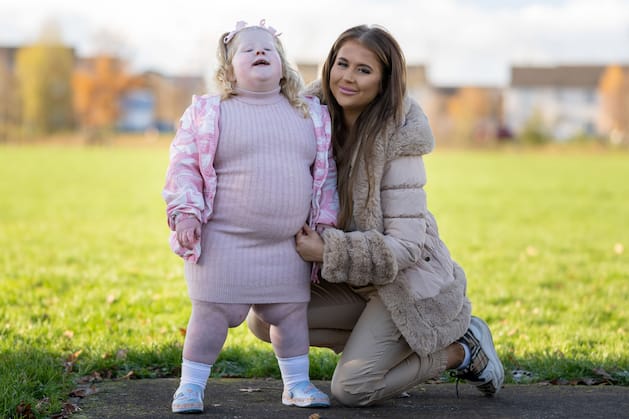Five-year-old Harlow Williams suffers from a rare condition called Prader-Willi Syndrome. It lacks chromosome 15. This causes, among other things, that those affected have no feeling of satiety. The background to a disease that affects every 15,000 babies.
Harlow Williams grins for the camera. The five-year-old, with blonde curls and dressed all in pink, radiates joie de vivre even in the photo. She’s a little fighter. Because Harlow suffers from Prader-Willi syndrome. You are missing chromosome 15.
“We knew from the moment she was born that something was different,” recalls mother Holly Williams in an interview with the British “Daily Mail”. “She was tiny and only weighed 2.1 kilos. Her body was very limp, she had no strength, did not cry and could not be fed properly.” Even then, doctors suspected that it was Prader-Willi syndrome (PWS).
Six months later, mother Holly got the official diagnosis. Like all people with PWS, Harlow was developmentally delayed – unable to support her head at eight months and unable to walk at two and a half years old. There was also an insatiable hunger. Because people with PWS have no feeling of satiety.
Harlow weighs 100 pounds at just five years old. The problem is that she’s so hungry that she breaks rules to get food, too. Mother Holly reports that she has already put a child’s gate on the kitchen door. She also thinks about locks. “It can be difficult to deal with sometimes,” she says. Because Harlow can get very angry then. “She throws her iPad, kicks her legs and screams and cries.” She then has to be very strict.
“But Harlow is my first and only child and I’ve never known it any other way.” The two have a “very close bond” and are together all the time, says Holly.
But how does PWS actually come about? “It is a whim of nature and can affect anyone,” writes the “Prader-Willi Syndrome” Association Germany. One in 15,000 newborns is affected.
The cause of PWS is a spontaneous chromosomal disorder, a defect on chromosome 15. This defect already occurs during the formation of the germ cells (egg and sperm cell) and causes a change in processes in the diencephalon, more precisely in the hypothalamus. It controls our food intake, but also our breathing, our sexual and emotional behavior and our sleep rhythm. It also regulates when and how much hormone is formed. An example of this is body growth. PWS sufferers are therefore short in stature.
Harlow’s story describes the classic symptoms of the disease. The Swiss Prader-Willi Center cites the following as the most important PWS characteristics:
It is considered to be one of the earliest signs of PWS. Affected fetuses move less in the womb. Babies often lie limp. The muscle weakness also affects the ability to suck and swallow, which is why babies often do not eat enough food and are underweight at first.
This changes drastically at the age of two to three years. A real craving develops. The children have no feeling of satiety. There is a risk of excessive weight gain with enormous obesity.
The genitals are usually not fully developed. In most cases, people with PWS have little sexual desire and are often infertile.
The psychomotor and intellectual development of children with PWS is usually slower. Speech and gross motor development (sitting, walking) are particularly delayed. There are clear differences.
Children with PWS often have temper tantrums. During puberty, depressive phases can occur. The unforeseen makes things difficult for them, so a regular daily routine is helpful.
People with PWS are short in stature. On average, women reach a height of 1.46 meters, men 1.52 meters.
The facial features are also noticeable: narrow face with a small forehead, almond-shaped eyes (sometimes squinting) and a mouth with a triangular shape. Sometimes people with PWS have lighter skin and hair than their parents. As a result of muscle weakness and obesity, they often develop a hunchback with a curvature of the spine.
The “Prader-Willi Syndrome” association in Germany cites life-threatening obesity and associated secondary diseases such as diabetes or cardiovascular diseases as a danger.
The association makes the following recommendations for action:
PWS is not curable. But: “The disease can be steered in a positive direction by a variety of therapies and measures,” writes the association. For example, through early educational and psychological support or growth hormones.
Basically, the range of symptoms varies from case to case, they can range from mild to very severe. Harlow, for example, still has mild mobility issues and suffers from sleep apnea, but is now in elementary school. This is not possible for all people with PWS. Mother Holly says: “Harlow is doing well and is a happy girl.”
Those affected can find more information on the website: www.prader-willi.de
